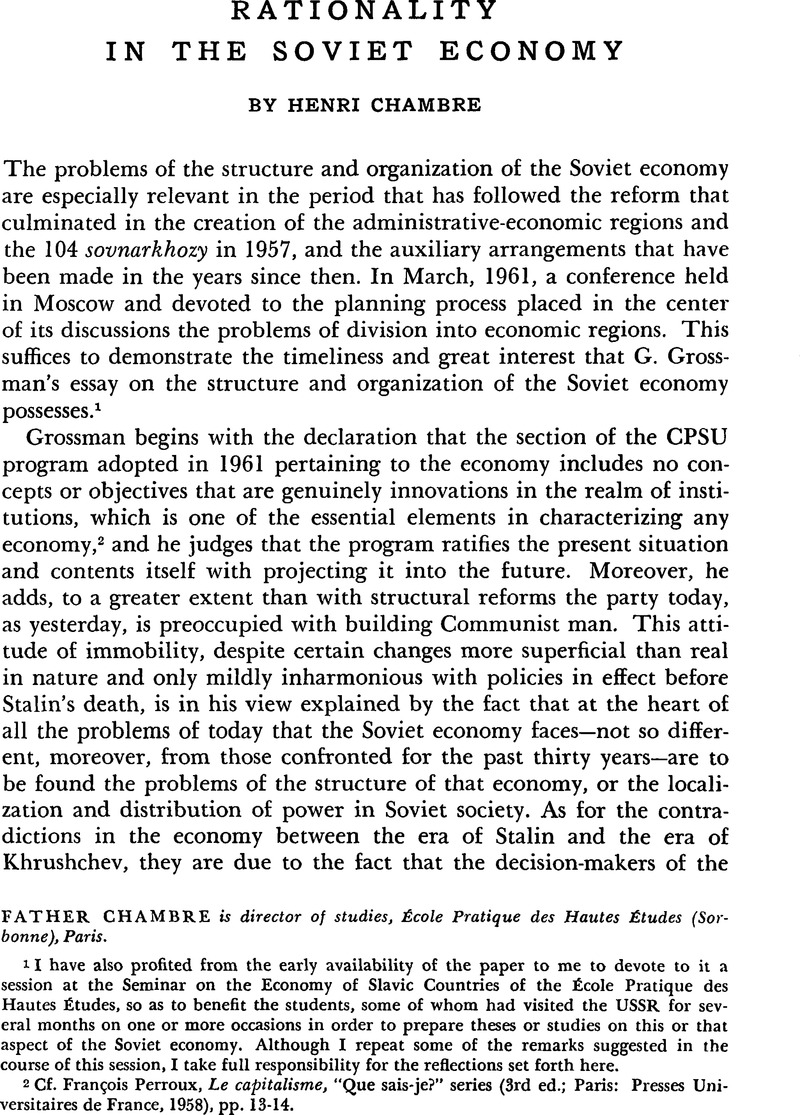No CrossRef data available.
Article contents
Rationality in the Soviet Economy
Published online by Cambridge University Press: 27 January 2017
Abstract

- Type
- Discussion
- Information
- Copyright
- Copyright © Association for Slavic, East European, and Eurasian Studies. 1962
References
1 I have also profited from the early availability of the paper to me to devote to it a session at the Seminar on the Economy of Slavic Countries of the École Pratique des Hautes Études, so as to benefit the students, some of whom had visited the USSR for several months on one or more occasions in order to prepare theses or studies on this or that aspect of the Soviet economy. Although I repeat some of the remarks suggested in the course of this session, I take full responsibility for the reflections set forth here.
2 Cf. Perroux, François, Le capitalisme, “Que sais-je?” series (3rd ed.; Paris: Presses Universitaires de France, 1958), pp. 13–14 Google Scholar.
3 Hersch, Cf. J., Idéologie et réaltiés (Paris: Plon, 1956), pp. 24 and 27Google Scholar. Rubel, M, “La croissance du capital en U.R.S.S. Essai de confrontation critique,” Économie Applique'e, No. 2/3, 1957 Google Scholar. Gerschenkron, Alexander in Continuity and Change in Russian and Soviet Thought, ed. Simmons, E. J. (Cambridge, Mass.: Harvard University Press, 1957), p. 107 Google Scholar, and in The Transformation of Russian Society, ed. C. E. Black (Cambridge: Harvard University Press, 1960), p. 61.
4 Cf. Gurvitch, Georges, “Classes urbaines et classes rurales” in Villes et campagnes, collection published under the direction of Friedmann, G. (Paris: A. Colin, 1953), p. 120 Google Scholar.
5 Perroux, F, “Esquisse d'une théorie de l'économie dominante,” Économie Appliquée, No. 2/3, 1948, p. 243 Google Scholar.
6 Cf. “Rationalité et croissances économiques soviétiques,” articles by Alec Nove, H. Chambre, Cahiers de 1'I.S.E.A., “Économie planifiée series, No. 104 (August, 1960).
7 Cf. Campbell, Robert W., “Marx, Kantorovich, and Novozhilov: Stoimost’ versus Reality,” Slavic Review, XX, No. 3 (Oct., 1961)Google Scholar.
8. cf.Perroux, , “L'univers économique et social,” Encyclopédie française, Vol. IX (Paris, 1960)Google Scholar. Hirschman, A. O., The Strategy of Economic Development (New Haven: Yale University Press, 1958)Google Scholar. Nove, Alec, The Soviet Economy (London: Allen & Unwin, 1961).Google Scholar
9 Perroux, F., La coexistence pacifique (Paris: Presses Universitaires de France, 1958), II, 478 Google Scholar.
10 Chambre, Cf. H., “Le développement du bassin du Kuznetsk,” Cahiers de 1'I.S.E.A., 11Économie planifiée” series, No. 100 (April, 1960)Google Scholar.
11 Cf. Merleau-Ponty, M., Les aventures de la dialectique (Paris: Gallimard, 1955, p. 303 Google Scholar.
12 Perroux, Cf. F., La valeur (Paris: Presses Universitaires de France, 1943), p. 587 Google Scholar.
13 H. Bartoli, in Esprit, No. 1, 1962, pp. 121–22.
14 Greyffié de Bellecombe, L., Les conventions collectives de travail en Union Soviétique, in the collection “Études sur l'économie et la sociologie des pays slaves,” École Pratique des Hautes Études (Paris: Mouton, 1958, p. 147 Google Scholar.




